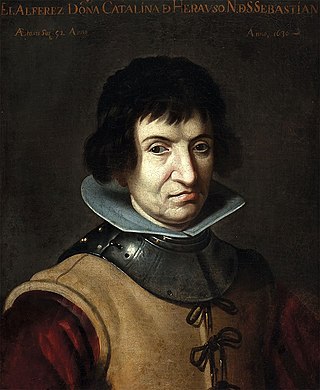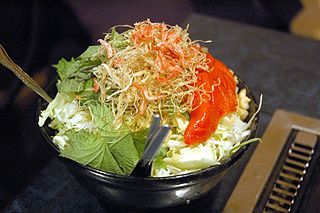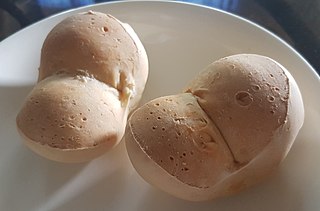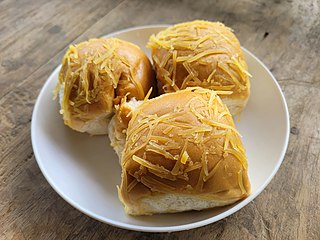Related Research Articles

Antonio de Erauso, born as Catalina de Erauso, also went by Alonso Díaz and some other masculine names, later taking on the name Antonio de Erauso which he went by for the remainder of his life. He is also known in Spanish as La Monja Alférez. de Erauso was originally an unwilling nun, but escaped the convent and travelled around Spain and Spanish America, mostly under male identities, in the first half of the 17th century. Erauso's story has remained alive through historical studies, biographical stories, novels, movies and comics.
The Orchester Musikkollegium Winterthur is a Swiss symphony orchestra based in Winterthur, Switzerland at its namesake venue, the Musikkollegium Winterthur. The orchestra performs around 60 concerts a year, and in addition to orchestra concerts, performs in the pit at the Zurich Opera.

Pan de coco, literally "coconut bread" in Spanish, is a Filipino rich sweet roll that uses sweetened shredded coconut meat (bukayo) as filling.

Monjayaki is a type of Japanese pan-fried batter, popular in the Kantō region, similar to okonomiyaki, but using different liquid ingredients.

Zenderman is a Japanese anime television series which first aired from February 3, 1979, to January 26, 1980, on every Saturday from 6:30 pm to 7:00 pm with a total of 52 episodes. It is the third show in the sequence of "Time Bokan Series" produced by Tatsunoko Productions. It was preceded by Yatterman and succeeded by Rescueman.

Venta del Moro is a municipality in the comarca of Requena-Utiel in the Valencian Community, Spain.

Santa Colomba de las Monjas is a municipality located in the province of Zamora, Castile and León, Spain. As of 2009, the municipality has a population of 294 inhabitants.
Madagascar for the Malagasy is a political party in Madagascar.
Lioux-les-Monges is a commune in the Creuse department in the Nouvelle-Aquitaine region in central France.

Chichén Itzá was a large pre-Columbian city built by the Maya people of the Terminal Classic period. The archeological site is located in Tinúm Municipality, Yucatán State, Mexico.
Monja Roindefo Zafitsimivalo is a Malagasy politician who was Prime Minister of Madagascar from March 2009 to October 2009. He was appointed on 7 February 2009 by opposition leader Andry Rajoelina at the head of Rajoelina's rival government; later, on 17 March, Andry Rajoelina was installed in power by the military, and Monja Roindefo officially took over as Prime Minister.
The Remains from the Shipwreck is a 1978 Spanish drama film directed by Ricardo Franco. It was entered into the 1978 Cannes Film Festival.

Hato Rey Central is one of the 18 barrios of the municipality of San Juan, Puerto Rico. With a population density of 16,155.3 per square mile. It has a land area of 1.03 sq mi and a 2010 Census population of 16,640.
Monja is a given name. Notable people with the name include:
"Il était une fois nous deux" is a song by Joe Dassin from his 1976 album Le Jardin du Luxembourg.

Monay, also known as pan de monja, is a dense bread roll from the Philippines made with all-purpose flour, milk, and salt. It has a characteristic shape, with an indentation down the middle dividing the bread into two round halves. It is a common humble fare, usually eaten for merienda with cheese or dipped in hot drinks.

Ube crinkles, also known as purple yam crinkles, are Filipino cookies made from purple yam, flour, eggs, baking powder, butter, and sugar. They are characteristically deep purple in color and are typically rolled in powdered sugar or glazed. They have a crunchy exterior and a soft chewy center.

Pinagong is a dense bread roll from the Philippines made with all-purpose flour, milk, and salt. It is a variant of pan de monja (monáy) distinguished primarily by its shape and the more complex pattern of scoring on top. The name means "made into a turtle", from Tagalog pagong ("turtle").

Putok or star bread is a dense bread roll from the Philippines made with all-purpose flour, milk, and salt. It is typically dusted with coarse white sugar. It is a variant of pan de monja (monáy) distinguished primarily by the crown or star-shaped top of the bread resulting from a cross-shaped cut on the dough prior to baking. The name literally means "explosion" or "fissure" in Tagalog.

Pan de siosa, also called pan de leche, is a Filipino pull-apart bread originating from the Visayas Islands of the Philippines. They characteristically have a very soft texture and are baked stuck together. They can be eaten plain with savory meat or soup dishes, or as a dessert brushed with a generous amount of butter and sprinkled with sugar and grated cheese. In Bacolod, they can also uniquely be toasted on a skewer and brushed with oil, margarine, or banana ketchup; and then eaten paired with inihaw dishes.
References
- ↑ Monja Liseki at National-Football-Teams.com
